Open Innovation Readiness Assessment within Students in Poland: Investigating State-of-the-Art and Challenges
Abstract
1. Introduction
2. Literature Review
2.1. Introduction to Open Innovation
2.2. The Transition from Open Innovation to Open Innovation 2.0
2.3. Open Innovation in the Context of SMEs
2.4. Open Innovation from the University’s Perspective
2.5. Open Innovation in Poland
- bureaucracy,
- corruption,
- the issue of trust,
- a lack of flexibility and the exploitation of external knowledge,
- internal resistance to ideas coming from outsiders or exploited by outsiders,
- a lack of employee autonomy, which is a key element in benefitting from OI successfully.
3. Research Methodology
Limitations
4. Research Results
4.1. Descriptive Analysis
4.2. Initial Quantitative Analysis
- social product development—ANN SPD (y is a factor variable with three levels: “Actively”, “Passively, and “Not”),
- crowdfunding—ANN CF (y is a factor variable with three levels: “Actively”, “Passively, and “Not”),
- crowdsourcing—ANN CS (y is a factor variable with three levels: “Actively”, “Passively, and “Not”),
- microworking—ANN micro (y is a factor variable with three levels: “Actively”, “Passively, and “Not”),
- sharing economy—ANN SE (y is a factor variable with three levels: “Actively”, “Passively, and “Not”).
5. Outlook on State-of-the-Art and Challenges—A Discussion
- RQ1: Do the students know directly or indirectly the open innovation paradigm?
- Almost all respondents actively use social media, which is a firm base to facilitate open innovation 2.0 activities among students in Poland. Platforms where one can share their new product ideas are known to slightly more than 20% of the respondents. These respondents, however, most often mentioned social media, such as Facebook or Instagram, rather than platforms dedicated to SPD. This shows that the majority does not know about SPD platforms and that there is an urgent need to raise awareness about this kind of possibility. Most respondents do not consider participating in open innovation activities. However, some respondents who consider such activities most often pointed to SPD and crowdfunding. Obtained answers show that over 50% of the surveyed students do not know the OI concept.
- What is more, the majority of respondents have never heard of the sharing economy, microworking, crowdfunding, and crowdsourcing; only slightly over 50% of the surveyed students have come across the term SPD. The vast majority of the surveyed students admitted that they had not participated in any of the surveyed activities in the field of open innovation. Again, this is information that the education process should enhance, with topics presenting the opportunities that OI brings.
- RQ2: Do the students use OI platforms passively or actively?
- The respondents were asked to rate their experience in particular areas of OI (on a 10-point scale). In this case, the highest average score was obtained by social product development, where the average score for the respondents’ experience was 4.6. The lowest average score was obtained by the experience gained in crowdsourcing, which was 3.9. The respondents rated highest the usefulness of activities in the field of social product development and the sharing economy as a research and innovation tool. The analysis of the obtained answers show that, from all of the investigated platforms—both international and Polish ones—only a few are used actively by a significant part of the surveyed students (Uber, BlaBlaCar, Bolt, Patronite, AirBnB, Amazon Mechanical Turk, zrzutka.pl, siepomaga.pl, pomagam.pl, patronite.pl, wspieram.to, polakpotrafi.pl, nextbike.pl and wspieramkulture.pl). It can also be seen that the overwhelming part of the respondents did not actively use the listed platforms at all—neither as a supporter, solution provider, nor as a project or campaign author. However, if the students use the OI platforms, they use them rather passively, especially as CF supporters or simply clients of these platforms, and especially those based on the sharing economy model. In terms of crowdfunding platforms, it can also be noticed that the students significantly support charity-oriented ones.
- RQ3: What is the source of knowledge about OI?
- According to over 3/4 of the respondents, the most important source of knowledge about open innovation is the Internet. The vast majority of respondents learned about opportunities, tools, and portals related to open innovation from the Internet—only 1% of the surveyed students mentioned university as the source of knowledge about OI.
- RQ4: How do students assess OI platforms, and what features do they find important?
- Most surveyed students positively assessed OI platforms, especially in terms of creativity, convenience, ease of use, and communicativeness. Less than half of the respondents could not clearly assess the issue of language barriers and the transparency of these websites. The respondents asked to rank how certain essential features of usage of OI tools and platforms were for them indicated that reasonable goal of the project, realistic goal of the project, description of the project, and trust in the authors of/ participants in the project were reasonably crucial for them. Personal acquaintance with the authors of or participants in the project was somewhat irrelevant for the majority of the respondents. Only slightly over 50% of the respondents found expected profits or other benefits significant.
- RQ5: What are the barriers to using OI platforms?
- Half of the respondents admitted that they encounter technical and thematic barriers when using portals and tools in the field of open innovation. While assessing the OI platforms, only language barriers were assessed negatively more often than other investigated features. This is consistent with the fact that over 40% of the respondents admitted that they do encounter language barriers. Moreover, over 35% of the surveyed students admitted that they do not trust this form of innovation, which is a considerable amount and is worrying.
- RQ6: Do the students find themselves creative and able to innovate/ develop new products?
- The answers to the last question are somewhat optimistic—6 out of 10 respondents consider themselves creative, while only less than 6% assess themselves explicitly as not creative people. 7 out of 10 respondents admitted that—with adequate motivation—they would be able to come up with a product idea. More than 1/3 of the respondents admitted that they managed to develop a product or thing that cannot be bought. More than half of the respondents admitted that if there were a portal where they could publish their ideas for products and earn money in return, they would use it. Over 30% of the respondents had no opinion on this subject, while less than 10% answered negatively.
6. Conclusions
Author Contributions
Funding
Institutional Review Board Statement
Informed Consent Statement
Conflicts of Interest
Appendix A
- (1)
- Do you actively use social media?
- (a)
- yes
- (b)
- no
- (2)
- Do you know any website where you can share your idea for a new product?
- (a)
- no
- (b)
- if so, please mention the addresses of these sites
- (3)
- Do you know the concept of open innovation?
- (a)
- yes
- (b)
- no
- (4)
- Have you ever come across the following terms?
| crowdsourcing | yes | no |
| crowdfunding | yes | no |
| microworking/microtasking | yes | no |
| sharing economy | yes | no |
| social product development | yes | no |
- (5)
- Can the following concepts be considered as elements of open innovation?
| crowdsourcing | yes | hard to say | no |
| crowdfunding | yes | hard to say | no |
| microworking/microtasking | yes | hard to say | no |
| sharing economy | yes | hard to say | no |
| social product development | yes | hard to say | no |
- (6)
- Have you ever been a participant in the following open innovation activities?
| crowdsourcing | no | yes, as a supporter | yes, as a solution provider | yes, as a challenge giver |
| crowdfunding | no | yes, as a supporter | yes, as a solution provider | yes, as a challenge giver |
| microworking/microtasking | no | yes, as a supporter | yes, as a solution provider | yes, as a challenge giver |
| sharing economy | no | yes, as a supporter | yes, as a solution provider | yes, as a challenge giver |
| social product development | no | yes, as a supporter | yes, as a solution provider | yes, as a challenge giver |
- (7)
- How would you rate your experience with open innovation on a scale of 1 (completely negative) to 10 (completely positive)?
| crowdsourcing | 1 | 2 | 3 | 4 | 5 | 6 | 7 | 8 | 9 | 10 |
| crowdfunding | 1 | 2 | 3 | 4 | 5 | 6 | 7 | 8 | 9 | 10 |
| microworking/microtasking | 1 | 2 | 3 | 4 | 5 | 6 | 7 | 8 | 9 | 10 |
| sharing economy | 1 | 2 | 3 | 4 | 5 | 6 | 7 | 8 | 9 | 10 |
| social product development | 1 | 2 | 3 | 4 | 5 | 6 | 7 | 8 | 9 | 10 |
- (8)
- Are you considering taking part in any open innovation activities in the future? (f the answer is “yes”, more than option may be indicated)
| crowdsourcing | yes, as a campaign supporter or a solution provider | yes, as the author of a project or a campaign | no |
| crowdfunding | yes, as a campaign supporter or a solution provider | yes, as the author of a project or a campaign | no |
| microworking/microtasking | yes, as a campaign supporter or a solution provider | yes, as the author of a project or a campaign | no |
| sharing economy | yes, as a campaign supporter or a solution provider | yes, as the author of a project or a campaign | no |
| social product development | yes, as a campaign supporter or a solution provider | yes, as the author of a project or a campaign | no |
- (9)
- Do you think open innovation activities are useful as a research and/or innovation tool? Mark your opinion on a scale of 1 (completely useless) to 10 (totally useful)
| crowdsourcing | 1 | 2 | 3 | 4 | 5 | 6 | 7 | 8 | 9 | 10 |
| crowdfunding | 1 | 2 | 3 | 4 | 5 | 6 | 7 | 8 | 9 | 10 |
| microworking/microtasking | 1 | 2 | 3 | 4 | 5 | 6 | 7 | 8 | 9 | 10 |
| sharing economy | 1 | 2 | 3 | 4 | 5 | 6 | 7 | 8 | 9 | 10 |
| social product development | 1 | 2 | 3 | 4 | 5 | 6 | 7 | 8 | 9 | 10 |
- (10)
- From the list below, indicate the international online platforms that you have ever used as a supporter, provider of solutions or as a project author
| Experiment-www.experiment.com | yes, as a campaign supporter or a solution provider | yes, as the author of a project or a campaign | no |
| Kickstarter-www.kickstarter.com | yes, as a campaign supporter or a solution provider | yes, as the author of a project or a campaign | no |
| Indiegogo-www.indiegogo.com | yes, as a campaign supporter or a solution provider | yes, as the author of a project or a campaign | no |
| NineSigma-www.ninesigma.com | yes, as a campaign supporter or a solution provider | yes, as the author of a project or a campaign | no |
| InnoCentive-www.innocentive.com | yes, as a campaign supporter or a solution provider | yes, as the author of a project or a campaign | no |
| Chaordix-www.chaordix.com | yes, as a campaign supporter or a solution provider | yes, as the author of a project or a campaign | no |
| Hirebotics-www.hirebotics.com | yes, as a campaign supporter or a solution provider | yes, as the author of a project or a campaign | no |
| Envoi AI-www.envoyai.com/exchange | yes, as a campaign supporter or a solution provider | yes, as the author of a project or a campaign | no |
| Connect + Develop-https://www.pgconnectdevelop.com/ | yes, as a campaign supporter or a solution provider | yes, as the author of a project or a campaign | no |
| Amazon Mechanical Turk-www.mturk.com | yes, as a campaign supporter or a solution provider | yes, as the author of a project or a campaign | no |
| Patronite.com | yes, as a campaign supporter or a solution provider | yes, as the author of a project or a campaign | no |
| Clickworker-www.clickworker.com | yes, as a campaign supporter or a solution provider | yes, as the author of a project or a campaign | no |
| IdeaConnection-www.ideaconnection.com | yes, as a campaign supporter or a solution provider | yes, as the author of a project or a campaign | no |
| PRESANS-www.presans.com | yes, as a campaign supporter or a solution provider | yes, as the author of a project or a campaign | no |
| Hypios CrowdInnovation-www.hypios-ci.com | yes, as a campaign supporter or a solution provider | yes, as the author of a project or a campaign | no |
| OpenIDEO-www.openideo.com | yes, as a campaign supporter or a solution provider | yes, as the author of a project or a campaign | no |
| CrowdSPRING-www.crowdspring.com | yes, as a campaign supporter or a solution provider | yes, as the author of a project or a campaign | no |
| SYNERGY PLATFORM-https://synergyplatform.pwr.edu.pl/ | yes, as a campaign supporter or a solution provider | yes, as the author of a project or a campaign | no |
| AirBnB | yes, as a campaign supporter or a solution provider | yes, as the author of a project or a campaign | no |
| Uber | yes, as a campaign supporter or a solution provider | yes, as the author of a project or a campaign | no |
| Bolt | yes, as a campaign supporter or a solution provider | yes, as the author of a project or a campaign | no |
| BlaBlaCar | yes, as a campaign supporter or a solution provider | yes, as the author of a project or a campaign | no |
| Other international platforms (which?) | yes, as a campaign supporter or a solution provider | yes, as the author of a project or a campaign | no |
- (11)
- From the list below, indicate Polish online platforms that you have ever used as a supporter, solution provider or as the author of a project or a campaign
| https://polakpotrafi.pl/ | yes, as a campaign supporter or a solution provider | yes, as the author of a project or a campaign | no |
| https://wspieram.to/ | yes, as a campaign supporter or a solution provider | yes, as the author of a project or a campaign | no |
| http://wspieramkulture.pl/ | yes, as a campaign supporter or a solution provider | yes, as the author of a project or a campaign | no |
| http://www.wspolnicy.pl/ | yes, as a campaign supporter or a solution provider | yes, as the author of a project or a campaign | no |
| https://zrzutka.pl/ | yes, as a campaign supporter or a solution provider | yes, as the author of a project or a campaign | no |
| https://odpalprojekt.pl/ | yes, as a campaign supporter or a solution provider | yes, as the author of a project or a campaign | no |
| https://beesfund.com/ | yes, as a campaign supporter or a solution provider | yes, as the author of a project or a campaign | no |
| https://findfunds.pl/ | yes, as a campaign supporter or a solution provider | yes, as the author of a project or a campaign | no |
| https://www.traficar.pl/ | yes, as a campaign supporter or a solution provider | yes, as the author of a project or a campaign | no |
| nextbike.pl | yes, as a campaign supporter or a solution provider | yes, as the author of a project or a campaign | no |
| bikeu.pl | yes, as a campaign supporter or a solution provider | yes, as the author of a project or a campaign | no |
| https://www.acro.bike/ | yes, as a campaign supporter or a solution provider | yes, as the author of a project or a campaign | no |
| Wspolnyprojekt.pl | yes, as a campaign supporter or a solution provider | yes, as the author of a project or a campaign | no |
| Megatotl.pl | yes, as a campaign supporter or a solution provider | yes, as the author of a project or a campaign | no |
| Stworzmistrza.pl | yes, as a campaign supporter or a solution provider | yes, as the author of a project or a campaign | no |
| Fans4club.com | yes, as a campaign supporter or a solution provider | yes, as the author of a project or a campaign | no |
| Pomagam.pl | yes, as a campaign supporter or a solution provider | yes, as the author of a project or a campaign | no |
| Siepomaga.pl | yes, as a campaign supporter or a solution provider | yes, as the author of a project or a campaign | no |
| Patronite.pl | yes, as a campaign supporter or a solution provider | yes, as the author of a project or a campaign | no |
| Other national platforms (which?) | yes, as a campaign supporter or a solution provider | yes, as the author of a project or a campaign | no |
- (12)
- Indicate what is, in your opinion, the most important source of knowledge about open innovations:
- (a)
- advertisement
- (b)
- press
- (c)
- TV
- (d)
- radio
- (e)
- Internet
- (f)
- friends/relatives
- (g)
- own search
- (h)
- other (what?)
- (13)
- How did you find out about the opportunities, tools, or portals related to open innovation?
- (a)
- advertisement
- (b)
- press
- (c)
- TV
- (d)
- radio
- (e)
- Internet
- (f)
- friends/relatives
- (g)
- own search
- (h)
- other (what?)
- (14)
- How do you rate the use of tools and portals related to open innovation due to:
| credibility | definitely positive | rather positive | neither positively nor negatively | rather negative | definitely negative |
| creativity | definitely positive | rather positive | neither positively nor negatively | rather negative | definitely negative |
| convenience | definitely positive | rather positive | neither positively nor negatively | rather negative | definitely negative |
| ease of use | definitely positive | rather positive | neither positively nor negatively | rather negative | definitely negative |
| language barriers | definitely positive | rather positive | neither positively nor negatively | rather negative | definitely negative |
| communicativeness | definitely positive | rather positive | neither positively nor negatively | rather negative | definitely negative |
| transparency | definitely positive | rather positive | neither positively nor negatively | rather negative | definitely negative |
- (15)
- Which of the following do you consider important in using open innovation tools and platforms? On a scale of 1-completely irrelevant to 5-definitely significant:
- (a)
- description of the project
- (b)
- language (way) of the description
- (c)
- personal acquaintance with the authors of or participants in the project
- (d)
- confirmed knowledge about the authors of or participants in the project
- (e)
- trust in the authors of or participants in the project
- (f)
- credible goal of the project
- (g)
- realistic goal of the project
- (h)
- the potential of the project
- (i)
- expected profits or other benefits
- (16)
- What kind of barriers do you encounter in using open innovation tools and platforms?
- (a)
- Language barriers (yes/no)
- (b)
- Thematic barriers (yes/no)
- (c)
- Technical barriers (yes/no)
- (d)
- I do not trust this form of innovation (yes/no)
- (e)
- Other, what kind?
- (17)
- Do you think you are a creative person?
- (a)
- yes
- (b)
- hard to say
- (c)
- no
- (18)
- Do you think that, with the right motivation, you could come up with your own product idea?
- (a)
- yes
- (b)
- hard to say
- (c)
- no
- (19)
- Have you ever come up with an item/product that cannot be bought?
- (a)
- yes
- (b)
- hard to say
- (c)
- no
- (20)
- If there was a portal where you could publish your ideas for products and make money on it, would you decide to use it?
- (a)
- yes
- (b)
- hard to say
- (c)
- no
Appendix B
- # regression model
- library(MASS)
- mydata<-read.table(“OI29varLM.txt”, header=T)
- attach(mydata)
- str(mydata)
- head(mydata,15)
- summary(mydata)
- class(mydata$Y)
- cbind(as.matrix(cor(mydata))[,1])
- set.seed(123)
- def_sets<-sample(2, nrow(mydata), replace = T, prob = c(0.7,0.3))
- training<-mydata[def_sets==1,]
- testing <-mydata[def_sets==2,]
- model=lm(Y~.-1, data=training)
- set.seed(123)
- model_BIC=step(model,direction =“backward”,trace=FALSE, k = log(nrow(training)) )
- model_BIC
- summary(model_BIC)
- Y_fitted_train=predict.lm(model_BIC, data=training)
- Y_fit_train=ifelse(Y_fitted_train>0.5,1,0)
- tab1<-table(training$Y,Y_fit_train)
- accuracy_training<- sum(diag(tab1))/sum(tab1)
- accuracy_training
- error_training<- 1-accuracy_training
- error_training
- Y_fitted_test=predict.lm(model_BIC, newdata=testing)
- Y_fit_test=ifelse(Y_fitted_test>0.5,1,0)
- tab2<-table(testing$Y,Y_fit_test)
- accuracy_testing<- sum(diag(tab2))/sum(tab2)
- accuracy_testing
- error_testing<- 1-accuracy_testing
- error_testing
- # artificial neural network model
- library(neuralnet)
- mydata<-read.table(“OI25var.txt”, header=T)
- attach(mydata)
- str(mydata$Y)
- head(mydata,15)
- summary(mydata)
- class(mydata$Y)
- #Not - 2 Passively - 3 Actively - 1
- set.seed(123)
- def_sets<-sample(2, nrow(mydata), replace = T, prob = c(0.7,0.3))
- training<-mydata[def_sets==1,]
- testing <-mydata[def_sets==2,]
- set.seed(123)
- for(i in 5:18)
- {
- ANN1<-neuralnet(Y~.
- data=training,
- hidden = i,
- err.fct = “sse”,
- algorithm = “rprop+”,
- stepmax = 10000000,
- linear.output = FALSE,
- lifesign = ‘minimal’)
- print(ANN1$result.matrix[1,1])
- forecast_train<- compute(ANN1,training[,-1])
- forecast_train$net.result
- Y_A=ifelse(training$Y==“Actively”,1,0)
- f_train_A=ifelse(forecast_train$net.result[,1]>0.5,1,0)
- Y_A
- f_train_A
- tab1<-table(Y_A, f_train_A)
- tab1
- Y_P=ifelse(training$Y==“Passively”,1,0)
- f_train_P=ifelse(forecast_train$net.result[,3]>0.5,1,0)
- Y_P
- f_train_P
- tab2<-table(Y_P,f_train_P)
- Y_N=ifelse(training$Y==“Not”,1,0)
- f_train_N=ifelse(forecast_train$net.result[,2]>0.5,1,0)
- Y_N
- f_train_N
- tab3<-table(Y_N, f_train_N)
- tab3
- Atrain=ifelse(max(f_train_A)==0,0,tab1[2,2])
- Atrain
- Ptrain=ifelse(max(f_train_P)==0,0,tab2[2,2])
- Ptrain
- Ntrain=ifelse(max(f_train_N)==0,0,tab3[2,2])
- Ntrain
- #TESTING
- forecast_test<- compute(ANN1,testing[,-1],)
- forecast_test$net.result
- Y_A=ifelse(testing$Y==“Actively”,1,0)
- f_test_A=ifelse(forecast_test$net.result[,1]>0.5,1,0)
- Y_A
- f_test_A
- tab4<-table(Y_A, f_test_A)
- tab4
- Y_P=ifelse(testing$Y==“Passively”,1,0)
- f_test_P=ifelse(forecast_test$net.result[,3]>0.5,1,0)
- Y_P
- f_test_P
- tab5<-table(Y_P, f_test_P)
- tab5
- Y_N=ifelse(testing$Y==“Not”,1,0)
- f_test_N=ifelse(forecast_test$net.result[,2]>0.5,1,0)
- Y_N
- f_test_N
- tab6<-table(Y_N, f_test_N)
- tab6
- Atest=ifelse(max(f_test_A)==0,0,tab4[2,2])
- Atest
- Ptest=ifelse(max(f_test_P)==0,0,tab5[2,2])
- Ptest
- Ntest=ifelse(max(f_test_N)==0,0,tab6[2,2])
- Ntest
- accuracy_training<- sum(Atrain, Ptrain, Ntrain)/length(training$Y)
- accuracy_training
- error_training<- 1-accuracy_training
- error_training
- accuracy_testing<- sum(Atest, Ptest, Ntest)/length(testing$Y)
- accuracy_testing
- error_testing<- 1-accuracy_testing
- error_testing
- print(i)
- print(accuracy_training)
- print(error_training)
- print(accuracy_testing)
- print(error_testing)
- plot(ANN1)
- }
- ANN1<-neuralnet(Y~.
- data=training,
- hidden = 5,
- rep=10,
- err.fct = “sse”,
- algorithm = “rprop+”,
- stepmax = 1000000,
- linear.output = FALSE,
- lifesign = ‘minimal’)
- print(ANN1$result.matrix[1,1])
- set.seed(123)
- for(i in 1:10)
- {
- forecast_train<- compute(ANN1,training[,-1], rep=i)
- forecast_train$net.result
- Y_A=ifelse(training$Y==“Actively”,1,0)
- f_train_A=ifelse(forecast_train$net.result[,1]>0.5,1,0)
- Y_A
- f_train_A
- tab1<-table(Y_A, f_train_A)
- tab1
- Y_P=ifelse(training$Y==“Passively”,1,0)
- f_train_P=ifelse(forecast_train$net.result[,3]>0.5,1,0)
- Y_P
- f_train_P
- tab2<-table(Y_P,f_train_P)
- tab2
- Y_N=ifelse(training$Y==“Not”,1,0)
- f_train_N=ifelse(forecast_train$net.result[,2]>0.5,1,0)
- Y_N
- f_train_N
- tab3<-table(Y_N, f_train_N)
- tab3
- Atrain=ifelse(max(f_train_A)==0,0,tab1[2,2])
- Atrain
- Ptrain=ifelse(max(f_train_P)==0,0,tab2[2,2])
- Ptrain
- Ntrain=ifelse(max(f_train_N)==0,0,tab3[2,2])
- Ntrain
- #TESTING
- forecast_test<- compute(ANN1,testing[,-1], rep=i)
- forecast_test$net.result
- Y_A=ifelse(testing$Y==“Actively”,1,0)
- f_test_A=ifelse(forecast_test$net.result[,1]>0.5,1,0)
- Y_A
- f_test_A
- tab4<-table(Y_A, f_test_A)
- tab4
- Y_P=ifelse(testing$Y==“Passively”,1,0)
- f_test_P=ifelse(forecast_test$net.result[,3]>0.5,1,0)
- Y_P
- f_test_P
- tab5<-table(Y_P, f_test_P)
- tab5
- Y_N=ifelse(testing$Y==“Not”,1,0)
- f_test_N=ifelse(forecast_test$net.result[,2]>0.5,1,0)
- Y_N
- f_test_N
- tab6<-table(Y_N, f_test_N)
- tab6
- Atest=ifelse(max(f_test_A)==0,0,tab4[2,2])
- Atest
- Ptest=ifelse(max(f_test_P)==0,0,tab5[2,2])
- Ptest
- Ntest=ifelse(max(f_test_N)==0,0,tab6[2,2])
- Ntest
- accuracy_training<- sum(Atrain, Ptrain, Ntrain)/length(training$Y)
- accuracy_training
- error_training<- 1-accuracy_training
- error_training
- accuracy_testing<- sum(Atest, Ptest, Ntest)/length(testing$Y)
- accuracy_testing
- error_testing<- 1-accuracy_testing
- error_testing
- print(i)
- print(accuracy_training)
- print(error_training)
- print(accuracy_testing)
- print(error_testing)
- }
- plot(ANN1, rep=4)
References
- Mubarak, M.F.; Petraite, M. Industry 4.0 Technologies, Digital Trust and Technological Orientation: What Matters in Open Innovation? Technol. Forecast. Soc. Chang. 2020, 161, 120332. [Google Scholar] [CrossRef]
- Obradović, T.; Vlačić, B.; Dabić, M. Open Innovation in the Manufacturing Industry: A Review and Research Agenda. Technovation 2021, 102, 102221. [Google Scholar] [CrossRef]
- Raghavan, A.; Demircioglu, M.A.; Orazgaliyev, S. COVID-19 and the New Normal of Organizations and Employees: An Overview. Sustainability 2021, 13, 11942. [Google Scholar] [CrossRef]
- Marullo, C.; Ahn, J.M.; Martelli, I.; Di Minin, A. Open for Innovation: An Improved Measurement Approach Using Item Response Theory. Technovation 2021, 109, 102338. [Google Scholar] [CrossRef]
- European Commission. Directorate General for Communications Networks, Content and Technology. In Open Innovation 2.0 Yearbook 2017–2018; European Commission Publications Office: Luxembourg, 2018. [Google Scholar]
- Curley, M. The Evolution of Open Innovation. J. Innov. Manag. 2015, 3, 9–16. [Google Scholar] [CrossRef]
- Hollanders, H.; Es-Sadki, N. European Innovation Scoreboard 2021; Publications Office of the European Union: Luxembourg, 2021. [Google Scholar]
- Chesbrough, H.W.; Vanhaverbeke, W. Open Innovation and Public Policy in the EU with Implications for SMEs. In Researching Open Innovation in SMEs; World Scientific: Singapore, 2018; pp. 455–492. ISBN 978-981-323-096-5. [Google Scholar]
- Usman, M.; Vanhaverbeke, W. How Start-Ups Successfully Organize and Manage Open Innovation with Large Companies. Eur. J. Innov. Manag. 2017, 20, 171–186. [Google Scholar] [CrossRef]
- Rosienkiewicz, M.; Helman, J.; Cholewa, M.; Molasy, M.; Krause-Juettler, G. Analysis and Assessment of Bottom-Up Models Developed in Central Europe for Enhancing Open Innovation and Technology Transfer in Advanced Manufacturing. In Sustainable Design and Manufacturing 2020; Scholz, S.G., Howlett, R.J., Setchi, R., Eds.; Smart Innovation, Systems and Technologies; Springer: Singapore, 2021; Volume 200, pp. 119–128. ISBN 9789811581304. [Google Scholar]
- Rosienkiewicz, M.; Helman, J.; Cholewa, M.; Molasy, M. SYNERGY Project: Open Innovation Platform for Advanced Manufacturing in Central Europe. In Intelligent Systems in Production Engineering and Maintenance; Burduk, A., Chlebus, E., Nowakowski, T., Tubis, A., Eds.; Springer International Publishing: Cham, Switzerland, 2019; Volume 835, pp. 306–315. ISBN 978-3-319-97489-7. [Google Scholar]
- McAdam, M.; Debackere, K. Beyond ‘Triple Helix’ toward ‘Quadruple Helix’ Models in Regional Innovation Systems: Implications for Theory and Practice: Beyond ‘Triple Helix’ toward ‘Quadruple Helix’ Models. RD Manag. 2018, 48, 3–6. [Google Scholar] [CrossRef]
- Inauen, M.; Schenker-Wicki, A. Fostering Radical Innovations with Open Innovation. Eur. J. Innov. Manag. 2012, 15, 212–231. [Google Scholar] [CrossRef]
- Wu, S.; Ding, X.; Liu, R.; Gao, H. How Does IT Capability Affect Open Innovation Performance? The Mediating Effect of Absorptive Capacity. Eur. J. Innov. Manag. 2019, 24, 43–65. [Google Scholar] [CrossRef]
- Zhou, F.; Liu, Y.; Chen, R. Research on Collaborative Innovation of Intelligent Connected Vehicles Industry Based on Test Field: Embedded Case Study from the Perspective of Open Innovation. Sustainability 2021, 13, 5880. [Google Scholar] [CrossRef]
- Klofsten, M.; Urbano, D.; Heaton, S. Managing Intrapreneurial Capabilities: An Overview. Technovation 2021, 99, 102177. [Google Scholar] [CrossRef]
- Xie, X.; Wang, H. How to Bridge the Gap between Innovation Niches and Exploratory and Exploitative Innovations in Open Innovation Ecosystems. J. Bus. Res. 2021, 124, 299–311. [Google Scholar] [CrossRef]
- Adnan, H.R.; Hidayanto, A.N.; Kurnia, S. Citizens’ or Government’s Will? Exploration of Why Indonesia’s Local Governments Adopt Technologies for Open Government. Sustainability 2021, 13, 11197. [Google Scholar] [CrossRef]
- Kitsios, F.; Kamariotou, M.; Grigoroudis, E. Digital Entrepreneurship Services Evolution: Analysis of Quadruple and Quintuple Helix Innovation Models for Open Data Ecosystems. Sustainability 2021, 13, 12183. [Google Scholar] [CrossRef]
- Available online: ec.europa.eu/digital-single-market/en/open-innovation-20 (accessed on 29 July 2021).
- Curley, M.; Salmelin, B. Open Innovation 2.0: A New Paradigm; European Commission: Luxembourg, 2013. [Google Scholar]
- Jarvenpaa, S.L.; Wernick, A. Paradoxical Tensions in Open Innovation Networks. Eur. J. Innov. Manag. 2011, 14, 521–548. [Google Scholar] [CrossRef]
- Chiaroni, D.; Chiesa, V.; Frattini, F. Investigating the Adoption of Open Innovation in the Bio-pharmaceutical Industry: A Framework and an Empirical Analysis. Eur. J. Innov. Manag. 2009, 12, 285–305. [Google Scholar] [CrossRef]
- Santos, R.S.; Soares, J.; Marques, P.C.; Navas, H.V.G.; Martins, J.M. Integrating Business, Social, and Environmental Goals in Open Innovation through Partner Selection. Sustainability 2021, 13, 12870. [Google Scholar] [CrossRef]
- Brabham, D.C. Crowdsourcing; The MIT Press essential knowledge series; The MIT Press: Cambridge, MA, USA; London, UK, 2013; ISBN 978-0-262-51847-5. [Google Scholar]
- What Is Crowdsourcing? Available online: https://www2.deloitte.com/content/dam/Deloitte/uk/Documents/Innovation/deloitte-uk-crowsourcing-what-is-crowdsourcing.pdf (accessed on 29 July 2021).
- Forbes, H.; Schaefer, D.; Han, J.; De Oliveira, F.B. Investigating Factors Influential on the Success of Social Product Development Initiatives. Procedia CIRP 2020, 91, 107–112. [Google Scholar] [CrossRef]
- Belk, R. You Are What You Can Access: Sharing and Collaborative Consumption Online. J. Bus. Res. 2014, 67, 1595–1600. [Google Scholar] [CrossRef]
- Hwang, J. Managing the Innovation Legitimacy of the Sharing Economy. Int. J. Qual. Innov. 2019, 5, 1. [Google Scholar] [CrossRef]
- Chabbouh, H.; Boujelbene, Y. Open Innovation in SMEs: The Mediating Role between Human Capital and Firm Performance. J. High Technol. Manag. Res. 2020, 31, 100391. [Google Scholar] [CrossRef]
- Hossain, M.; Kauranen, I. Open Innovation in SMEs: A Systematic Literature Review. J. Strategy Manag. 2016, 9, 58–73. [Google Scholar] [CrossRef]
- Liu, L.; Zhang, H. How Does Inter-Organizational Relational Governance Propel Firms’ Open Innovation? A Conditional Process Analysis. Sustainability 2021, 13, 10209. [Google Scholar] [CrossRef]
- Van de Vrande, V.; de Jong, J.P.J.; Vanhaverbeke, W.; de Rochemont, M. Open Innovation in SMEs: Trends, Motives and Management Challenges. Technovation 2009, 29, 423–437. [Google Scholar] [CrossRef]
- Ebersberger, B.; Bloch, C.; Herstad, S.J.; Van De Velde, E. Open Innovation Practices and Their Effect on Innovation Performance. Int. J. Innov. Technol. Manag. 2012, 9, 1250040. [Google Scholar] [CrossRef]
- Parida, V.; Westerberg, M.; Frishammar, J. Inbound Open Innovation Activities in High-Tech SMEs: The Impact on Innovation Performance. J. Small Bus. Manag. 2012, 50, 283–309. [Google Scholar] [CrossRef]
- Hervas-Oliver, J.-L.; Sempere-Ripoll, F.; Boronat-Moll, C. Technological Innovation Typologies and Open Innovation in SMEs: Beyond Internal and External Sources of Knowledge. Technol. Forecast. Soc. Chang. 2021, 162, 120338. [Google Scholar] [CrossRef]
- Popa, S.; Soto-Acosta, P.; Martinez-Conesa, I. Antecedents, Moderators, and Outcomes of Innovation Climate and Open Innovation: An Empirical Study in SMEs. Technol. Forecast. Soc. Chang. 2017, 118, 134–142. [Google Scholar] [CrossRef]
- Brunswicker, S.; Vanhaverbeke, W. Open Innovation in Small and Medium-Sized Enterprises (SMEs): External Knowledge Sourcing Strategies and Internal Organizational Facilitators. J. Small Bus. Manag. 2015, 53, 1241–1263. [Google Scholar] [CrossRef]
- Chen, Y.; Vanhaverbeke, W.; Du, J. The Interaction between Internal R&D and Different Types of External Knowledge Sourcing: An Empirical Study of Chinese Innovative Firms: Interaction between Internal R&D and Different Types of External Knowledge Sourcing. RD Manag. 2016, 46, 1006–1023. [Google Scholar] [CrossRef]
- De Marco, C.E.; Martelli, I.; Di Minin, A. European SMEs’ Engagement in Open Innovation When the Important Thing Is to Win and Not Just to Participate, What Should Innovation Policy Do? Technol. Forecast. Soc. Chang. 2020, 152, 119843. [Google Scholar] [CrossRef]
- Kapetaniou, C.; Lee, S.H. Geographical Proximity and Open Innovation of SMEs in Cyprus. Small Bus. Econ. 2019, 52, 261–276. [Google Scholar] [CrossRef]
- Leckel, A.; Veilleux, S.; Dana, L.P. Local Open Innovation: A Means for Public Policy to Increase Collaboration for Innovation in SMEs. Technol. Forecast. Soc. Chang. 2020, 153, 119891. [Google Scholar] [CrossRef]
- Radicic, D.; Pugh, G. Performance Effects of External Search Strategies in European Small and Medium-Sized Enterprises. J. Small Bus. Manag. 2017, 55, 76–114. [Google Scholar] [CrossRef]
- Radziwon, A.; Bogers, M. Open Innovation in SMEs: Exploring Inter-Organizational Relationships in an Ecosystem. Technol. Forecast. Soc. Chang. 2019, 146, 573–587. [Google Scholar] [CrossRef]
- Verbano, C.; Crema, M.; Venturini, K. The Identification and Characterization of Open Innovation Profiles in Italian Small and Medium-Sized Enterprises. J. Small Bus. Manag. 2015, 53, 1052–1075. [Google Scholar] [CrossRef]
- Vanhaverbeke, W. Managing Open Innovation in SMEs; Cambridge University Press: Cambridge, UK, 2017; ISBN 978-1-139-68098-1. [Google Scholar]
- Yi, R.; Wang, H.; Lyu, B.; Xia, Q. Does Venture Capital Help to Promote Open Innovation Practice? Evidence from China. Eur. J. Innov. Manag. 2021. [Google Scholar] [CrossRef]
- Aleksić, D.; Rangus, K.; Slavec Gomezel, A. Microfoundations of SME Open Innovation: The Role of Help, Knowledge Sharing and Hiding. Eur. J. Innov. Manag. 2021. [Google Scholar] [CrossRef]
- Bigliardi, B.; Ivo Dormio, A.; Galati, F. The Adoption of Open Innovation within the Telecommunication Industry. Eur. J. Innov. Manag. 2012, 15, 27–54. [Google Scholar] [CrossRef]
- Urbinati, A.; Landoni, P.; Cococcioni, F.; De Giudici, L. Stakeholder Management in Open Innovation Projects: A Multiple Case Study Analysis. Eur. J. Innov. Manag. 2021, 24, 1595–1624. [Google Scholar] [CrossRef]
- Dong, J.Q.; Netten, J. Information Technology and External Search in the Open Innovation Age: New Findings from Germany. Technol. Forecast. Soc. Chang. 2017, 120, 223–231. [Google Scholar] [CrossRef]
- Gewald, H.; Birkle, M. Open Innovation in the German SME Sector—Development and Test of a Diffusion Model. Prog. Mach. Syst. 2012, 1, 11. [Google Scholar]
- Bogers, M.; Burcharth, A.; Chesbrough, H. Open Innovation in Brazil: Exploring Opportunities and Challenges. Int. J. Innov. 2019, 7, 178–791. [Google Scholar] [CrossRef]
- Vélez-Rolón, A.M.; Méndez-Pinzón, M.; Acevedo, O.L. Open Innovation Community for University–Industry Knowledge Transfer: A Colombian Case. J. Open Innov. Technol. Mark. Complex. 2020, 6, 181. [Google Scholar] [CrossRef]
- Oganisjana, K. Promotion of University Students’ Collaborative Skills in Open Innovation Environment. J. Open Innov. Technol. Mark. Complex. 2015, 1, 18. [Google Scholar] [CrossRef]
- Bogers, M. Student-Oriented Teaching by Using an Open Innovation Game; University of Southern Denmark: Sønderborg, Denmark, 2011; p. 15. ISBN 978-1-4709-1566-7. [Google Scholar]
- Howells, J.; Ramlogan, R.; Cheng, S. Universities in an Open Innovation System: A UK Perspective. Int. J. Entrep. Behav. Res. 2012, 18, 440–456. [Google Scholar] [CrossRef]
- Eroğlu, I.; Ekmekçioğlu, D. Exploring the Relation between Students’ Research Behaviours in Project Courses and Open Innovation. Des. Technol. Educ. Int. J. 2018, 23, 45–60. [Google Scholar]
- Stanisławski, R.; Lisowsk, R. The Relations between Innovation Openness (Open Innovation) and the Innovation Potential of SMEs. Procedia Econ. Financ. 2015, 23, 1521–1526. [Google Scholar] [CrossRef][Green Version]
- Sachpazidu-Wójcicka, K. Open Innovation and Technology Transfer in Polish Enterprises. J. Manag. Financ. Sci. 2016, 9, 179. [Google Scholar]
- Runiewicz-Wardyn, M. Towards Building Open Innovation Ecosystem in Poland: Challenges and Opportunities. Kwart. Nauk. Przedsiębiorstwie 2020, 2, 15–27. [Google Scholar] [CrossRef]
- Dziurski, P.; Sopińska, A. Does Industry Matter? Drivers and Barriers for Open Innovation in High-Tech and Non-High-Tech Industries—Evidence from Poland. Int. J. Manag. Econ. 2020, 56, 307–323. [Google Scholar] [CrossRef]
- Baron, M. Open Innovation Capacity of the Polish Universities. J. Knowl. Econ. 2021, 12, 73–95. [Google Scholar] [CrossRef]
- Guerrero, M.; Heaton, S.; Urbano, D. Building Universities’ Intrapreneurial Capabilities in the Digital Era: The Role and Impacts of Massive Open Online Courses (MOOCs). Technovation 2021, 99, 102139. [Google Scholar] [CrossRef]
- Gyamfi, S.; Sein, Y.Y. Determinants of Sustainable Open Innovations—A Firm-Level Capacity Analysis. Sustainability 2021, 13, 9088. [Google Scholar] [CrossRef]
- Isaac, S.; Michael, W.B. Handbook in Research and Evaluation: A Collection of Principles, Methods, and Strategies Useful in Planning, Design, and Evaluation of Studies in Education and the Behavioral Sciences, 3rd ed.; Educational and Industrial Testing Services: San Diego, CA, USA, 1997. [Google Scholar]
- Questionnaire Survey. Available online: https://www.sciencedirect.com/topics/earth-and-planetary-sciences/questionnaire-survey (accessed on 28 July 2021).
- Marketing Research and Information Systems. (Marketing and Agribusiness Texts-4), Chapter 4: Questionnaire Design. Available online: http://www.fao.org/3/w3241e/w3241e05.htm (accessed on 28 July 2021).
- Cavallo, A.; Burgers, H.; Ghezzi, A.; van de Vrande, V. The Evolving Nature of Open Innovation Governance: A Study of a Digital Platform Development in Collaboration with a Big Science Centre. Technovation 2021, in press. [CrossRef]
- Yström, A.; Aspenberg, H.; Kumlin, A. Exploring the Creative Climate in an Open Innovation Arena: Identifying Challenges and Possibilities. Eur. J. Innov. Manag. 2015, 18, 70–85. [Google Scholar] [CrossRef]
- Available online: https://heinnovate.eu/en (accessed on 30 July 2021).
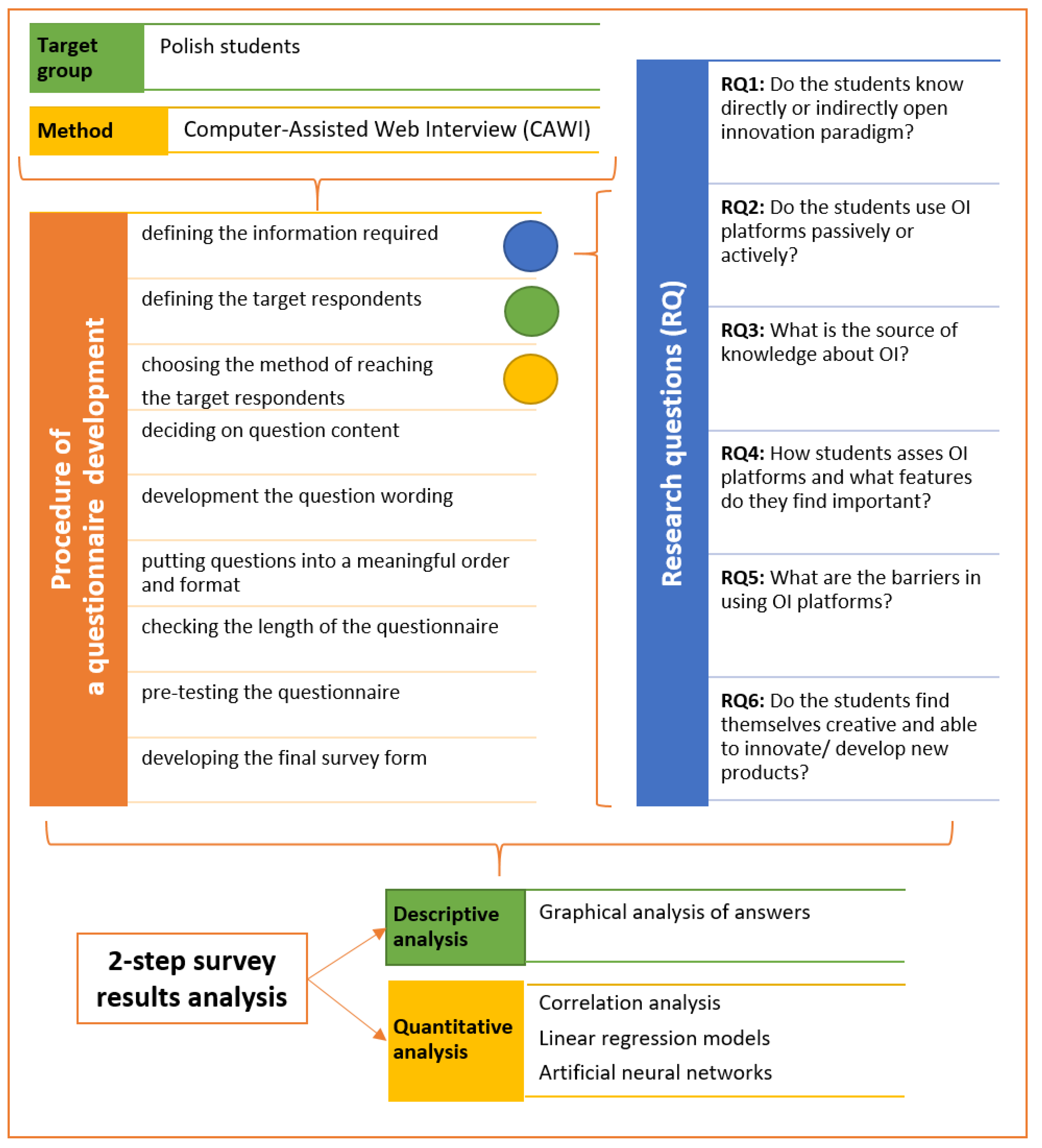


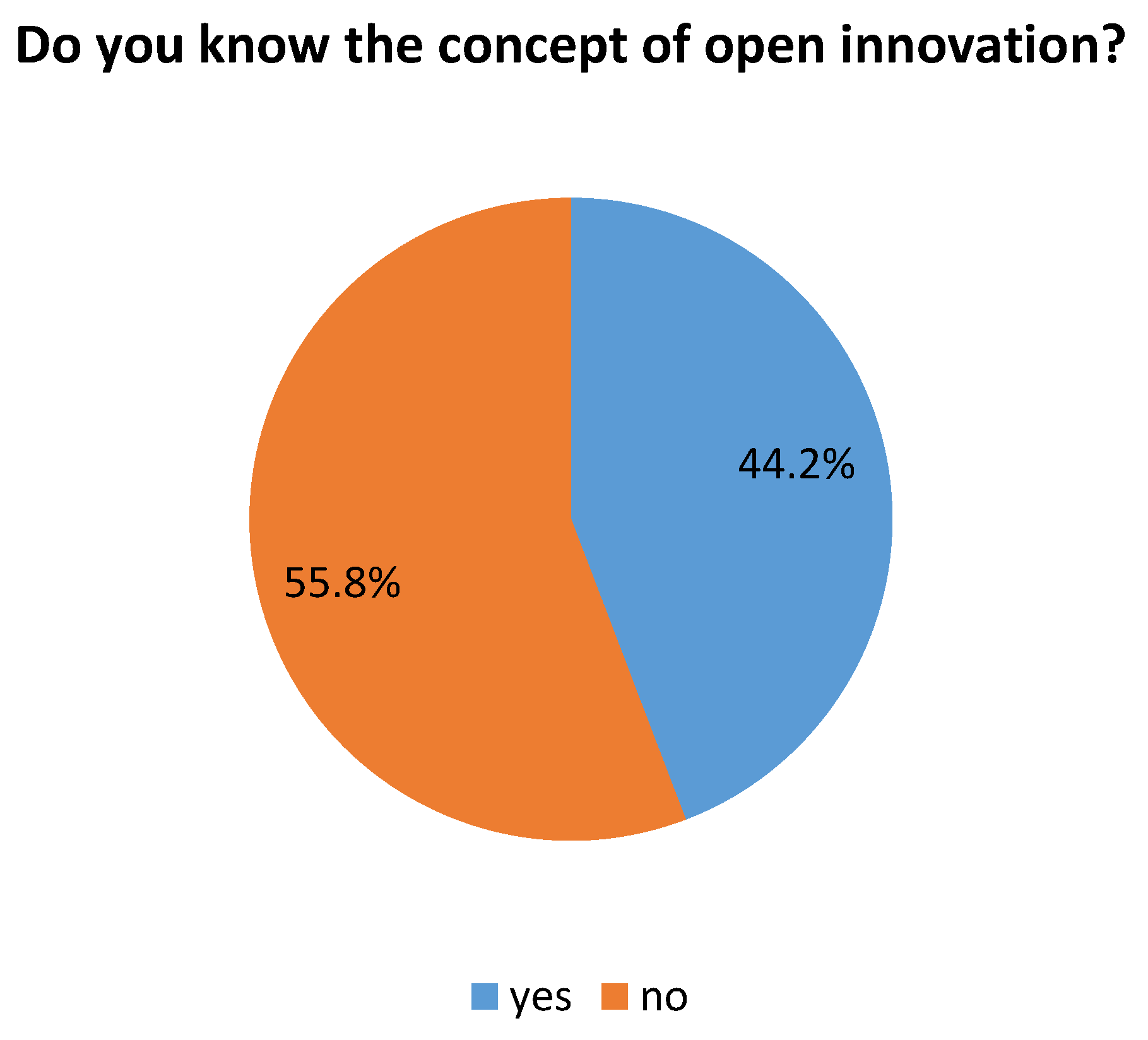
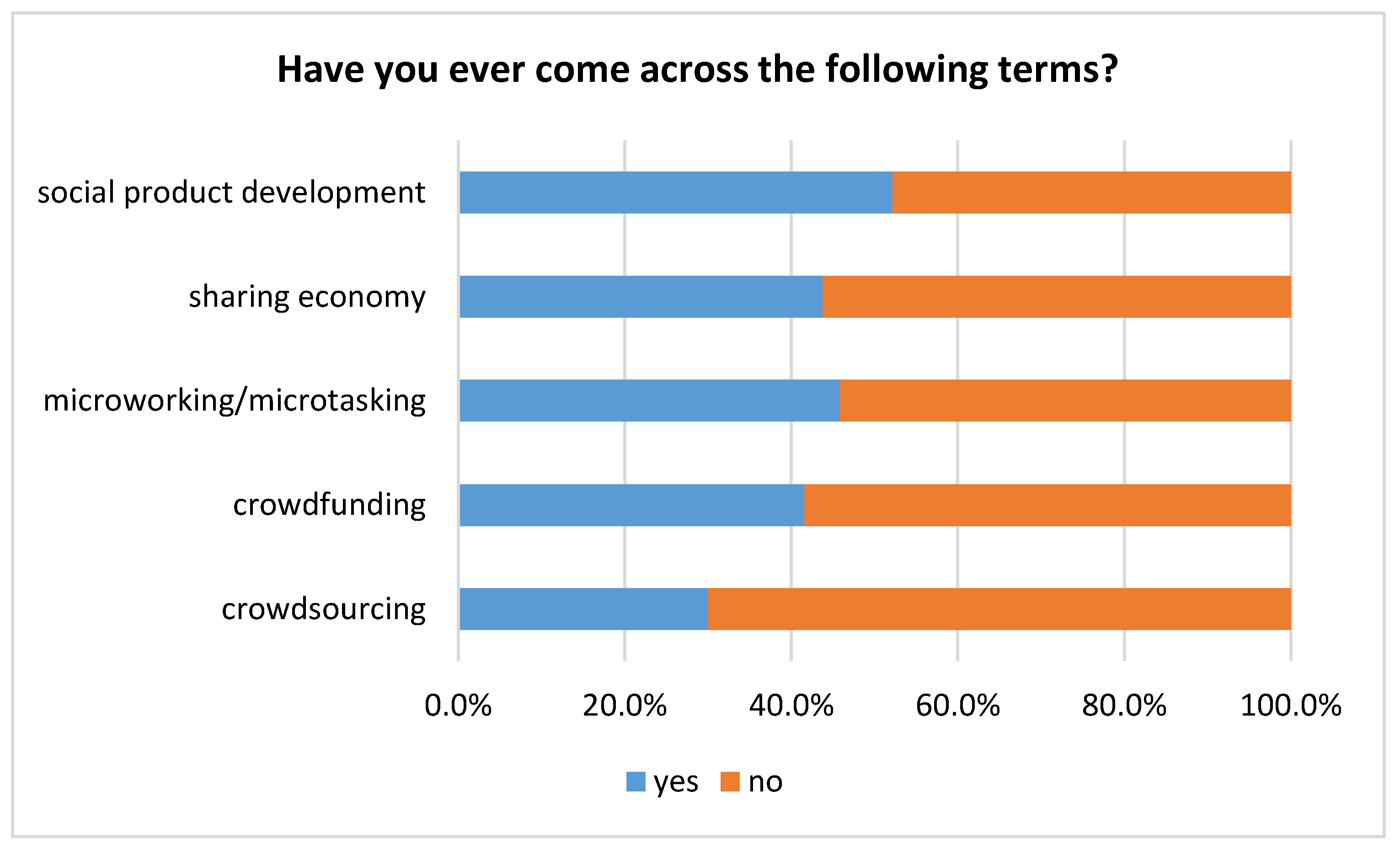


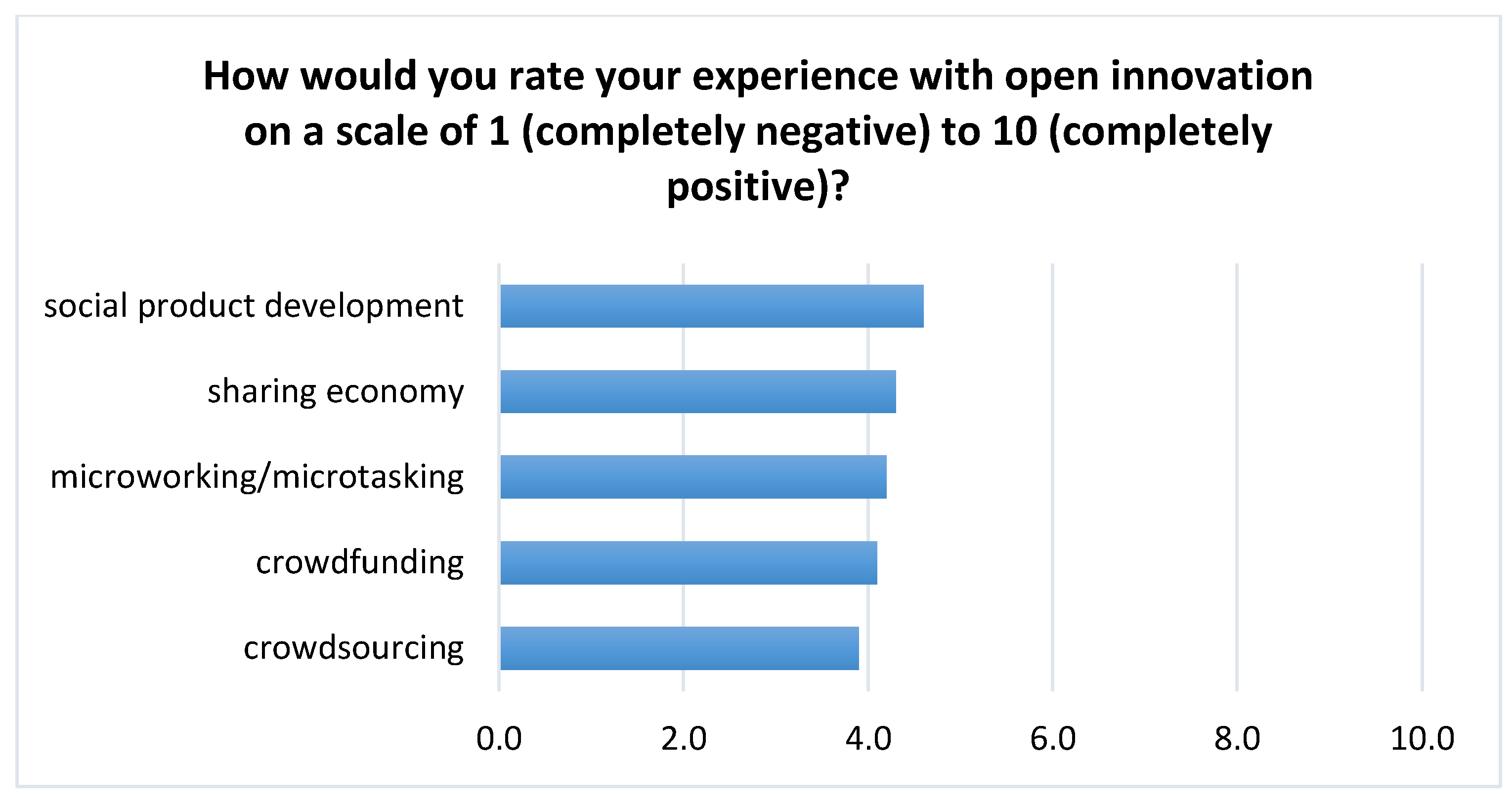
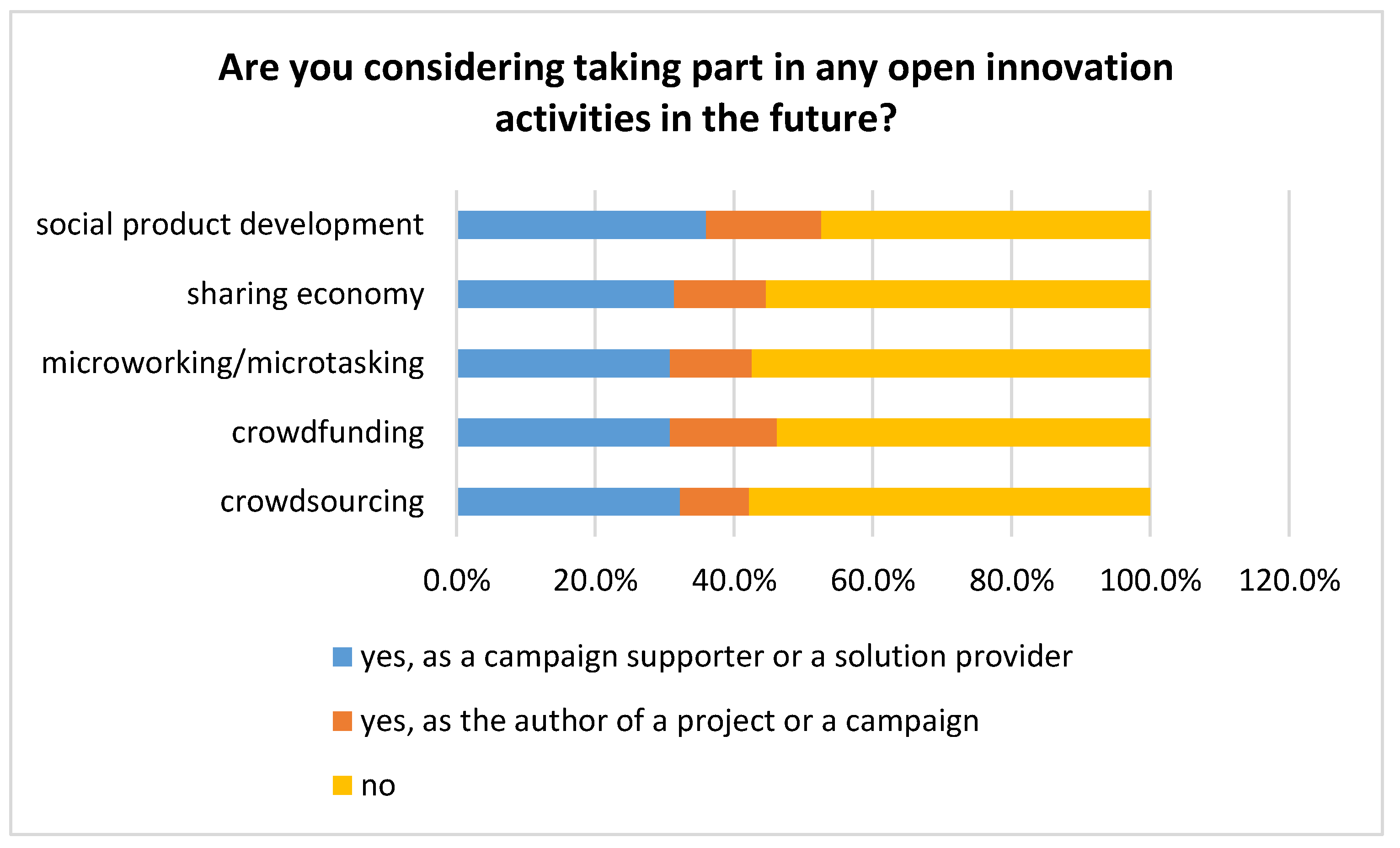
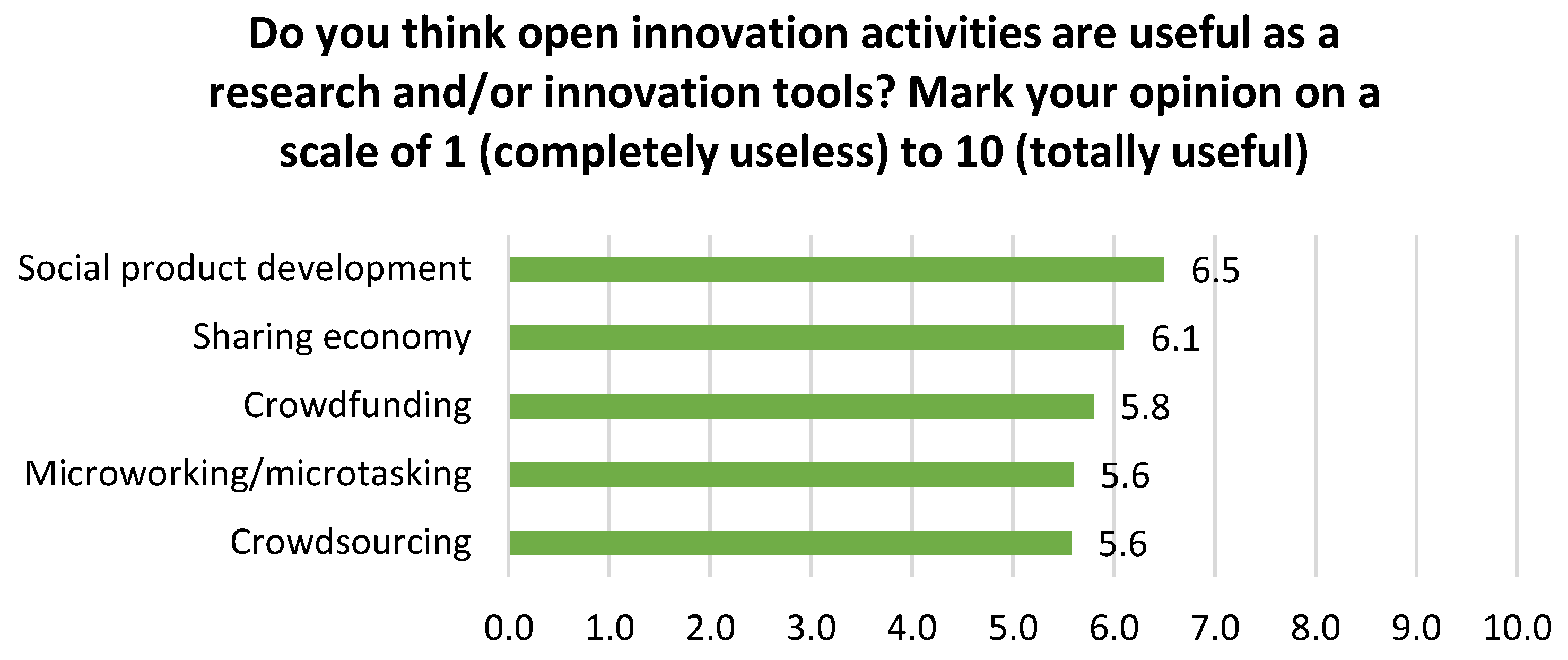
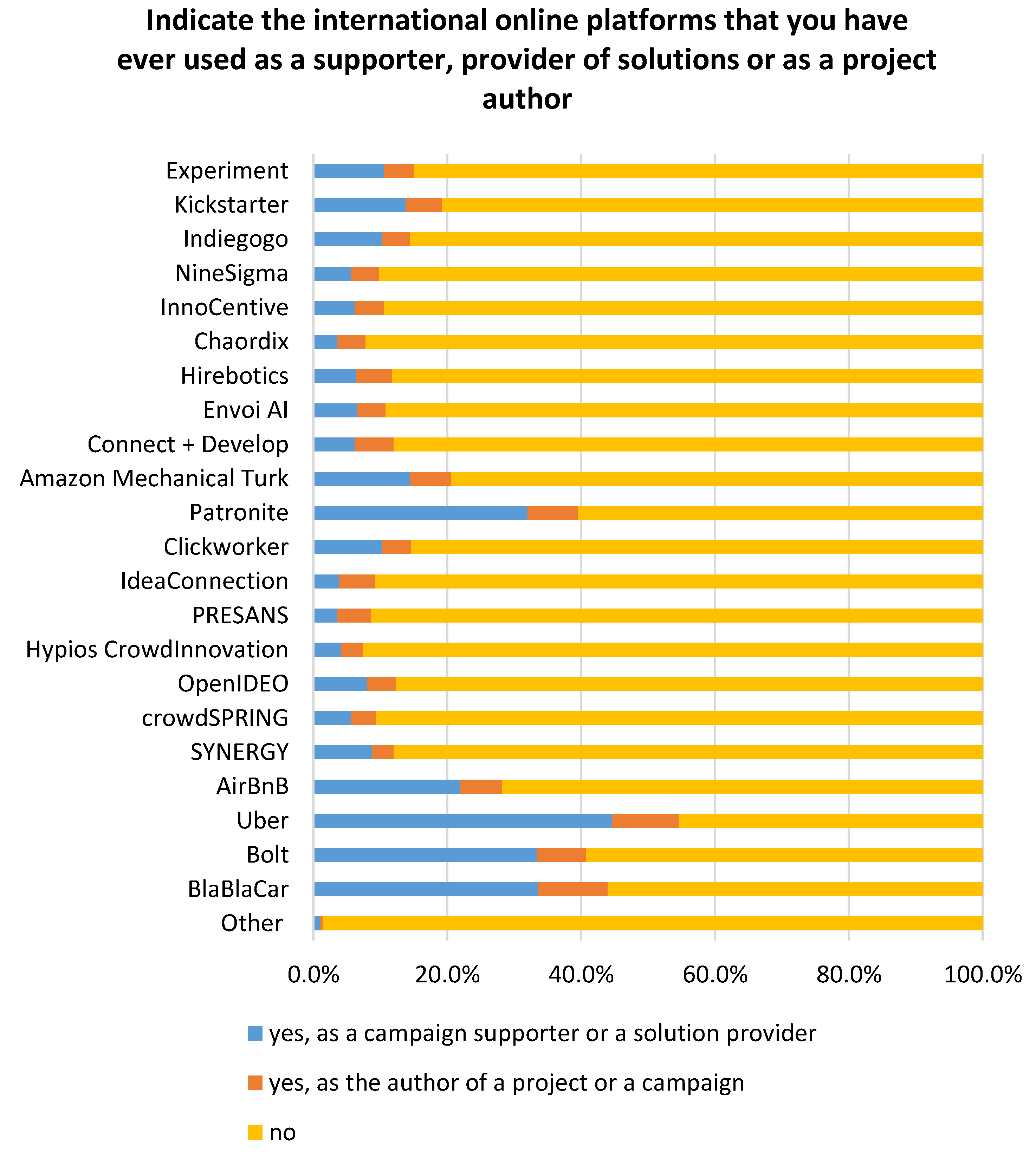


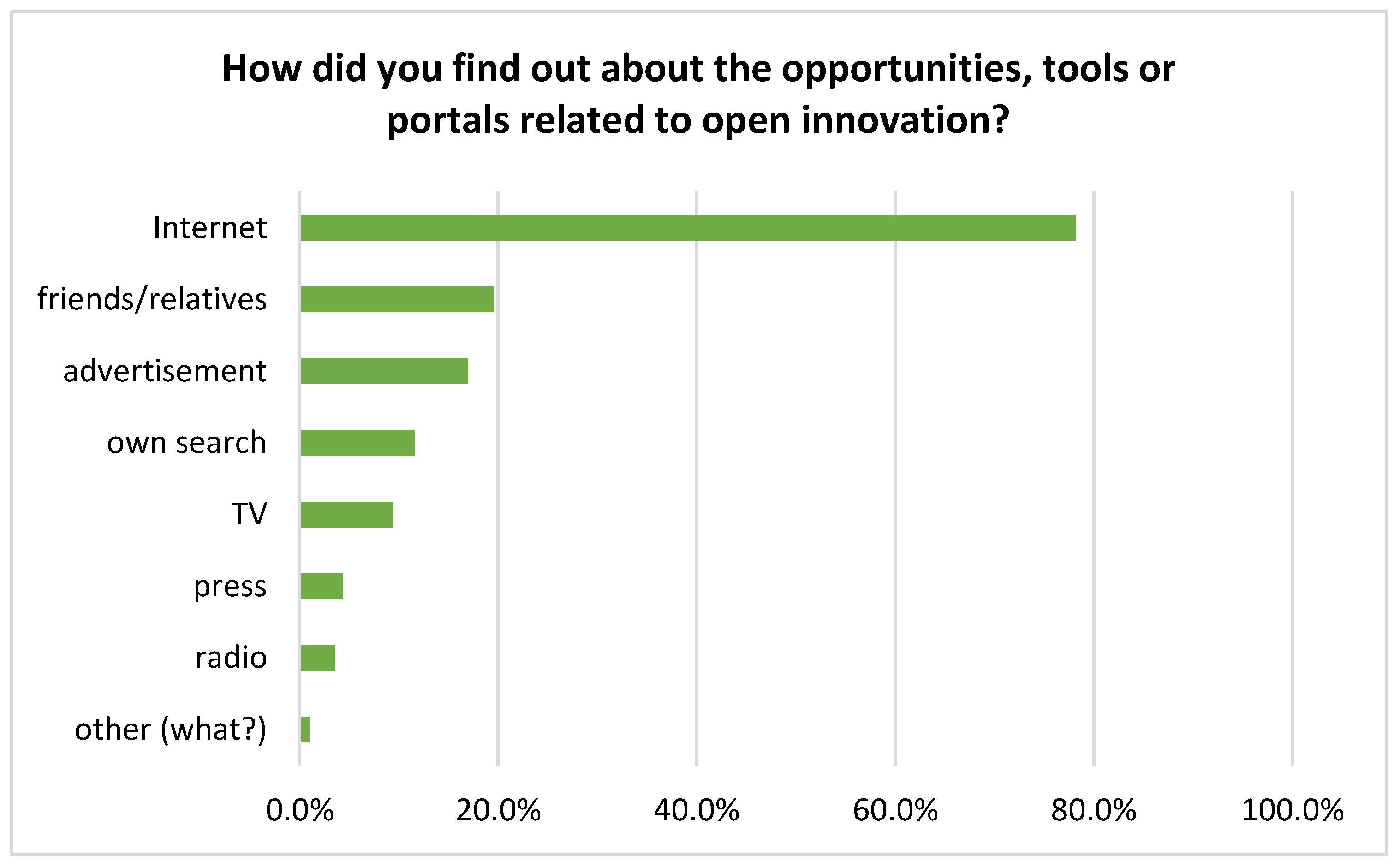
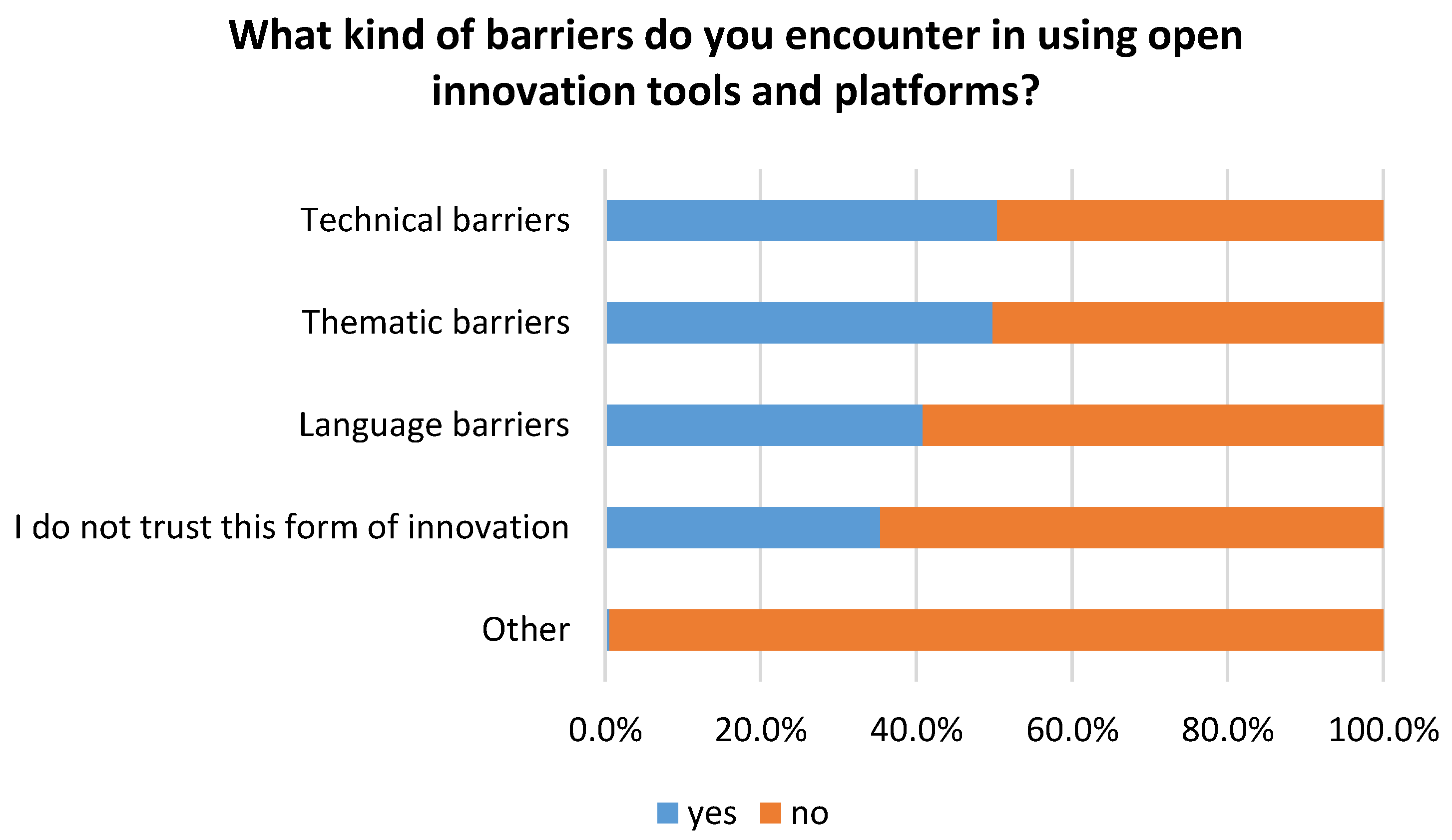
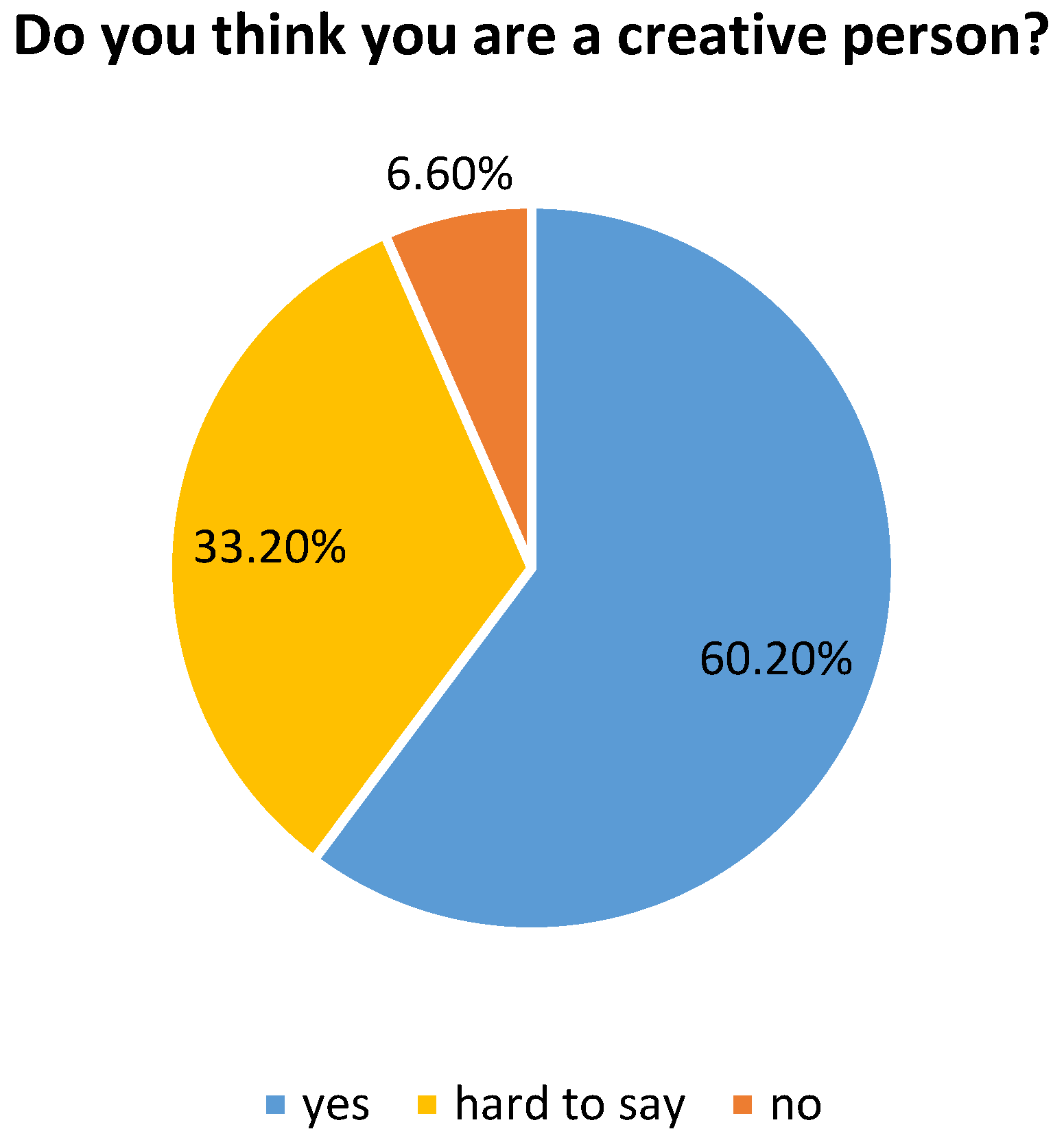

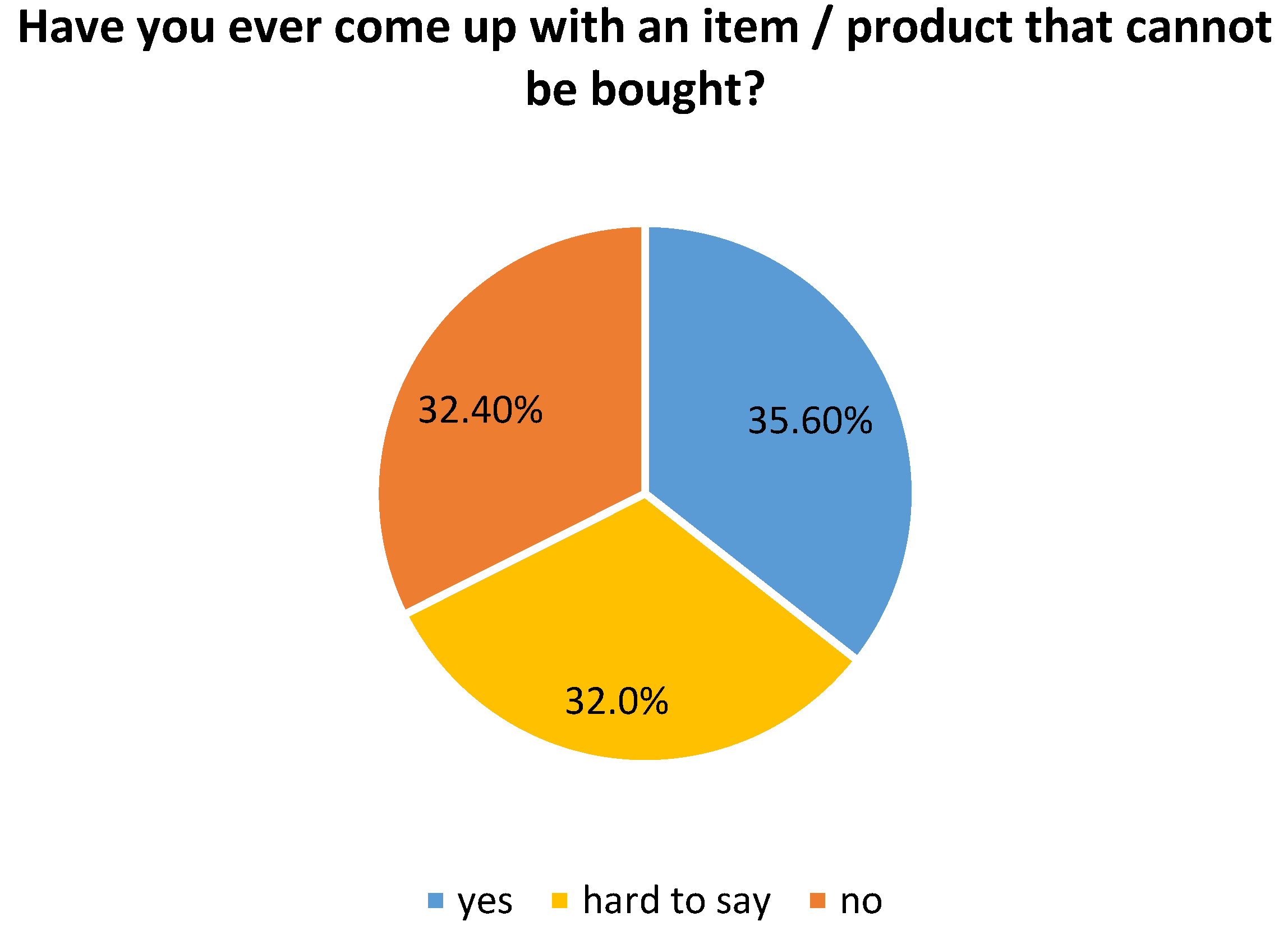
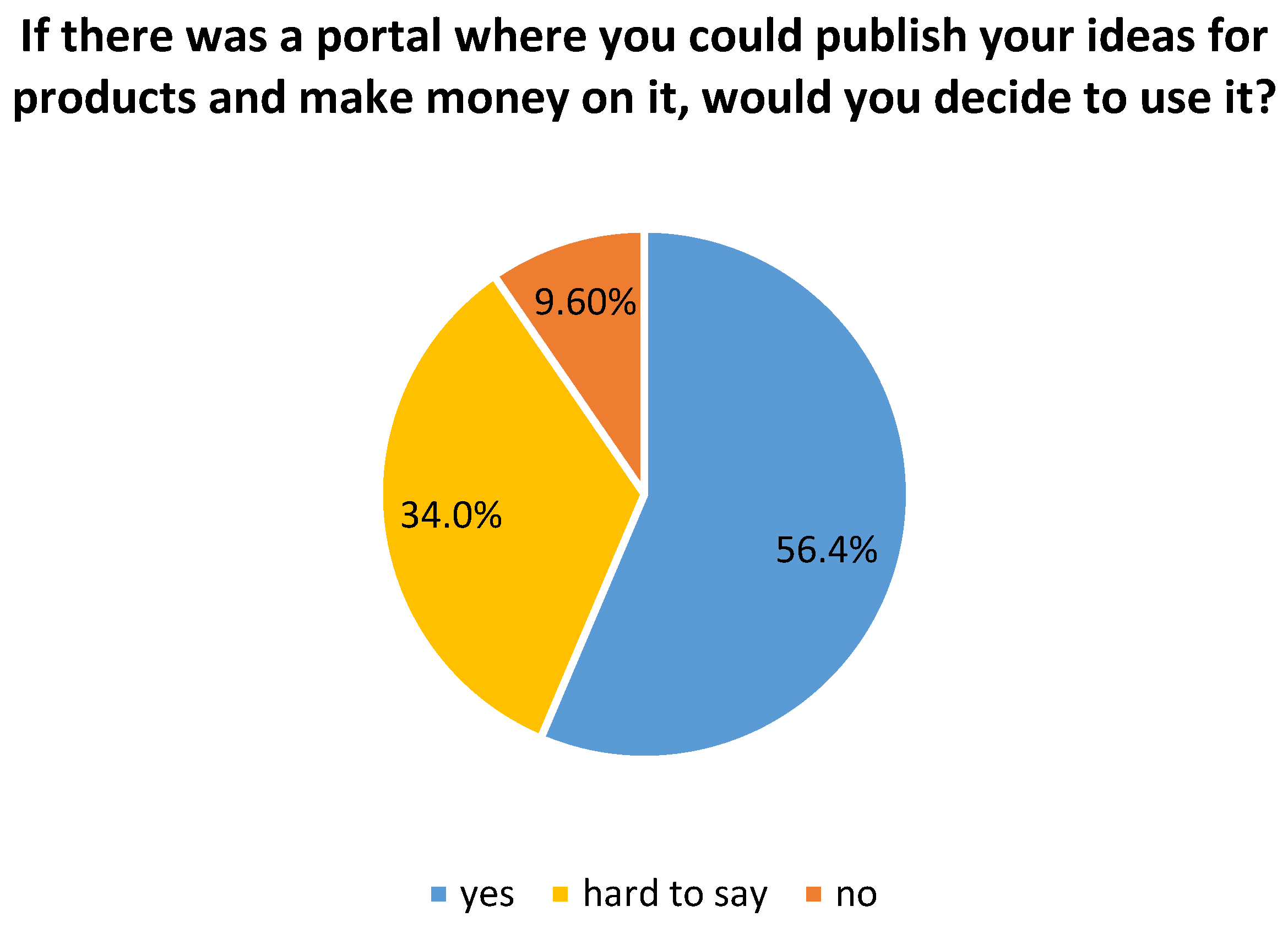
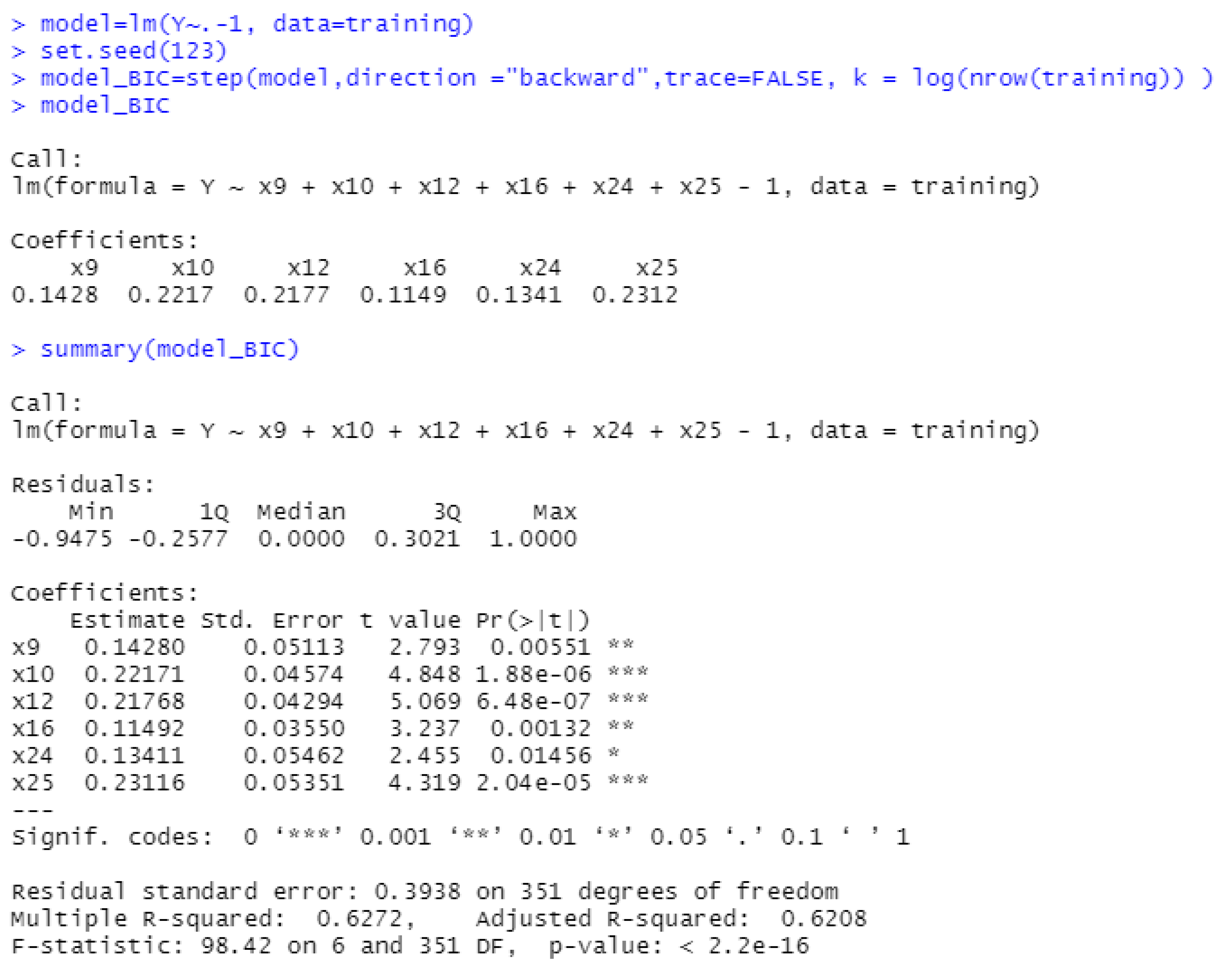

| Portals | Number of Indications (n) |
|---|---|
| 53 | |
| 53 | |
| 14 | |
| 11 | |
| Youtube | 7 |
| Kickstarter.com | 5 |
| Producthero.pl | 4 |
| Definitely Negative | Rather Negative | Neither Positive Nor Negative | Rather Positive | Definitely Positive | |
|---|---|---|---|---|---|
| Credibility | 0.8% | 6.0% | 35.8% | 50.8% | 6.6% |
| Creativity | 0.0% | 2.4% | 19.0% | 45.2% | 33.4% |
| Convenience | 0.2% | 2.8% | 22.8% | 47.6% | 26.6% |
| Ease of use | 0.4% | 3.8% | 31.0% | 44.4% | 20.4% |
| Language barriers | 2.0% | 10.2% | 48.2% | 30.2% | 9.4% |
| Communicativeness | 0.6% | 4.2% | 31.0% | 50.0% | 14.2% |
| Transparency | 1.2% | 7.0% | 42.6% | 40.4% | 8.8% |
| Feature: | 1— Completely Irrelevant | 2 | 3 | 4 | 5— Definitely Significant |
|---|---|---|---|---|---|
| description of the project | 2.2% | 6.2% | 21.2% | 22.6% | 47.8% |
| language (way) of the description | 3.6% | 8.0% | 26.0% | 33.4% | 29.0% |
| personal acquaintance with the authors or participants of the project | 11.2% | 23.2% | 36.2% | 18.4% | 11.0% |
| confirmed knowledge about the authors or participants of the project | 3.0% | 9.0% | 27.0% | 32.0% | 29.0% |
| trust in the authors or participants of the project | 1.2% | 6.6% | 22.2% | 28.4% | 41.6% |
| credible goal of the project | 1.6% | 3.4% | 15.8% | 22.0% | 57.2% |
| realistic goal of the project | 2.0% | 6.0% | 19.6% | 26.0% | 46.4% |
| the potential of the project | 2.2% | 7.2% | 27.2% | 36.6% | 26.8% |
| expected profits or other benefits | 5.6% | 10.8% | 31.6% | 31.6% | 20.4% |
| xi | Correlation With y | Explanation of Variables |
|---|---|---|
| x1 | −0.03 | Sex (1-woman; 0-man) |
| x2 | 0.04 | City 20,000–100,000 inhabitants (1-yes; 0-no) |
| x3 | 0,05 | City over 500,000 inhabitants (1-yes; 0-no) |
| x4 | 0.04 | City 200,000–500,000 inhabitants (1-yes; 0-no) |
| x5 | −0.01 | City 100,000–200,000 inhabitants (1-yes; 0-no) |
| x6 | 0.003 | City up to 20,000 inhabitants (1-yes; 0-no) |
| x7 | 0.11 | Higher education (1-yes; 0-no) |
| x8 | 0.08 | Working (1-working; 0-not working) |
| x9 | 0.21 | Knows a website where one can share their idea for a new product (1-yes; 0-no) |
| x10 | 0.44 | Knows the concept of open innovation (1-yes; 0-no) |
| x11 | 0.33 | Is familiar with the “crowdsourcing” term (1-yes; 0-no) |
| x12 | 0.35 | Is familiar with the “crowdfunding” term (1-yes; 0-no) |
| x13 | 0.28 | Is familiar with the “microworking/microtasking” terms (1-yes; 0-no) |
| x14 | 0.32 | Is familiar with the “sharing economy” term (1-yes; 0-no) |
| x15 | 0.34 | Is familiar with the “social product development” term (1-yes; 0-no) |
| x16 | 0.21 | Thinks they are a creative person (1-yes; 0-no) |
| x17 | 0.07 | Encounters language barriers in using open innovation tools and platforms (1-yes; 0-no) |
| x18 | 0.04 | Encounters thematic barriers in using open innovation tools and platforms (1-yes; 0 no) |
| x19 | 0.04 | Encounters technical barriers in using open innovation tools and platforms (1-yes; 0-no) |
| x20 | −0.05 | Does not trust this form of innovation(1-yes; 0-no) |
| x21 | 0.27 | Rate of experience with crowdsourcing on a scale of 1 (completely negative) to 10 (completely positive) (>5-1; 5 or <5-0) |
| x22 | 0.39 | Rate of experience with crowdfunding on a scale of 1 (completely negative) to 10 (completely positive) (>5-1; 5 or <5-0) |
| x23 | 0.31 | Rate of experience with microworking/microtasking on a scale of 1 (completely negative) to 10 (completely positive) (>5-1; 5 or <5-0) |
| x24 | 0.35 | Rate of experience with sharing economy on a scale of 1 (completely negative) to 10 (completely positive) (>5-1; 5 or <5-0) |
| x25 | 0.42 | Rate of experience with social product development on a scale of 1 (completely negative) to 10 (completely positive) (>5-1; 5 or <5-0) |
| Model Assessment | Results |
|---|---|
| accuracy_training | 77.31% |
| error_training | 22.69% |
| accuracy_testing | 74.13% |
| error_testing | 25.87% |
| Model’s Features | Crowdsourcing | Crowdfunding | Microworking | Sharing Economy | Social Product Development | |||||
|---|---|---|---|---|---|---|---|---|---|---|
| Accuracy training | 84.87% | 83.19% | 80.95% | 82.91% | 82.35% | |||||
| Error training | 15.13% | 16.81% | 19.05% | 17.09% | 17.65% | |||||
| Accuracy testing | 86.71% | 88.11% | 84.62% | 81.82% | 79.02% | |||||
| Error testing | 13.29% | 11.89% | 15.38% | 18.18% | 20.98% | |||||
| R2 | 37.55% | 45.71% | 42.98% | 45.22% | 48.73% | |||||
| Variables | Var. | Coeff. | Var. | Coeff. | Var. | Coeff. | Var. | Coeff. | Var. | Coeff. |
| x10 | 0.1296 | x10 | 0.1667 | x10 | 0.1424 | x11 | 0.1665 | x9 | 0.1487 | |
| x11 | 0.1805 | x12 | 0.1905 | x13 | 0.1916 | x14 | 0.1420 | x15 | 0.1518 | |
| x21 | 0.2318 | x22 | 0.2857 | x23 | 0.2930 | x24 | 0.3472 | x17 | 0.1138 | |
| x25 | 0.3223 | |||||||||
| Number of Hidden Neurons | Error | Accuracy Training | Error Training | Accuracy Testing | Error Testing |
|---|---|---|---|---|---|
| hidden: 5 thresh: 0.01 rep: 1/1 steps: 212,337 | error: 31.75086 | 93.56% | 6.44% | 68.53% | 31.47% |
| hidden: 6 thresh: 0.01 rep: 1/1 steps: 45,532 | error: 22.72864 | 90.48% | 9.52% | 62.24% | 37.76% |
| hidden: 7 thresh: 0.01 rep: 1/1 steps: 2735 | error: 16.55145 | 93.56% | 6.44% | 62.94% | 37.06% |
| hidden: 8 thresh: 0.01 rep: 1/1 steps: 2532 | error: 23.72 | 92.16% | 7.84% | 58.74% | 41.26% |
| hidden: 9 thresh: 0.01 rep: 1/1 steps: 4544 | error: 12.21719 | 95.80% | 4.20% | 63.64% | 36.36% |
| hidden: 10 thresh: 0.01 rep: 1/1 steps: 2434 | error: 8.89941 | 96.36% | 3.64% | 57.34% | 42.66% |
| hidden: 11 thresh: 0.01 rep: 1/1 steps: 1760 | error: 10.30415 | 96.36% | 3.64% | 59.44% | 40,56% |
| hidden: 12 thresh: 0.01 rep: 1/1 steps: 2313 | error: 4.76932 | 98.60% | 1.40% | 63.64% | 36.36% |
| hidden: 13 thresh: 0.01 rep: 1/1 steps: 1207 | error: 7.38981 | 96.64% | 3.36% | 58.74% | 41.26% |
| hidden: 14 thresh: 0.01 rep: 1/1 steps: 1711 | error: 4.89199 | 98.04% | 1.96% | 66.43% | 33.57% |
| hidden: 15 thresh: 0.01 rep: 1/1 steps: 713 | error: 7.02209 | 98.04% | 1.96% | 64.34% | 35.66% |
| hidden: 16 thresh: 0.01 rep: 1/1 steps: 925 | error: 4.92829 | 97.76% | 2.24% | 62.94% | 37.06% |
| hidden: 17 thresh: 0.01 rep: 1/1 steps: 553 | error: 6.05068 | 97.76% | 2.24% | 63.64% | 36.36% |
| hidden: 18 thresh: 0.01 rep: 1/1 steps: 704 | error: 4.91805 | 98.04% | 1.96% | 64.34% | 35.66% |
| ANN Model | Accuracy Training | Error Training | Accuracy Testing | Error Testing |
|---|---|---|---|---|
| ANN 1, rep = 1 | 77.59% | 22.41% | 55.94% | 44.06% |
| ANN 2, rep = 2 | 90.76% | 9.24% | 63.64% | 36.36% |
| ANN 3, rep = 3 | 87.96% | 12.04% | 65.73% | 34.27% |
| ANN 4, rep = 4 | 95.24% | 4.76% | 70.63% | 29.37% |
| ANN 5, rep = 5 | 91.88% | 8.12% | 60.84% | 39.16% |
| ANN 6, rep = 6 | 87.39% | 12.61% | 60.14% | 39.86% |
| ANN 7, rep = 7 | 93.28% | 6.72% | 69.23% | 30.77% |
| ANN 8, rep = 8 | 87.11% | 12.89% | 60.84% | 39.16% |
| ANN 9, rep = 9 | 77.03% | 22.97% | 58.74% | 41.26% |
| ANN 10, rep = 10 | 85.43% | 14.57% | 63.64% | 36.36% |
| Output y | The Best Model Out Of: | Hidden Neurons | Rep. | Steps | ANN Error | Training Set | Testing Set | ||
|---|---|---|---|---|---|---|---|---|---|
| Accuracy | Error | Accuracy | Error | ||||||
| ANN SPD | initial 14 models | 6 | 1/1 | 2839 | 1,478,024 | 94.68% | 5.32% | 75.52% | 24.48% |
| ANN SPD | final 10 models | 6 | 5/10 | 6153 | 107,658 | 97.48% | 2.52% | 75.52% | 24.48% |
| ANN CF | initial 14 models | 12 | 1/1 | 824 | 722,844 | 96.92% | 3.08% | 81.82% | 18.18% |
| ANN CF | final 10 models | 12 | 3/10 | 523 | 779,917 | 98.04% | 1.96% | 81.82% | 18.18% |
| ANN CS | initial 14 models | 5 | 1/1 | 120,664 | 984,409 | 97.76% | 2.24% | 86.01% | 13.99% |
| ANN CS | final 10 models | 5 | 2/10 | 3213 | 129,286 | 94.68% | 5.32% | 85.31% | 14.69% |
| ANN micro | initial 14 models | 17 | 1/1 | 286 | 604,069 | 98.60% | 1.40% | 79.72% | 20.28% |
| ANN micro | final 10 models | 17 | 2/10 | 496 | 356,057 | 98.88% | 1.12% | 79.72% | 20.28% |
| ANN SE | initial 14 models | 5 | 1/1 | 9324 | 2,038,719 | 94.40% | 5.60% | 78.32% | 21.68% |
| ANN SE | final 10 models | 5 | 5/10 | 112,887 | 1,425,886 | 94.68% | 5.32% | 77.62% | 22.38% |
Publisher’s Note: MDPI stays neutral with regard to jurisdictional claims in published maps and institutional affiliations. |
© 2022 by the authors. Licensee MDPI, Basel, Switzerland. This article is an open access article distributed under the terms and conditions of the Creative Commons Attribution (CC BY) license (https://creativecommons.org/licenses/by/4.0/).
Share and Cite
Rosienkiewicz, M.; Helman, J.; Cholewa, M.; Molasy, M. Open Innovation Readiness Assessment within Students in Poland: Investigating State-of-the-Art and Challenges. Sustainability 2022, 14, 1213. https://doi.org/10.3390/su14031213
Rosienkiewicz M, Helman J, Cholewa M, Molasy M. Open Innovation Readiness Assessment within Students in Poland: Investigating State-of-the-Art and Challenges. Sustainability. 2022; 14(3):1213. https://doi.org/10.3390/su14031213
Chicago/Turabian StyleRosienkiewicz, Maria, Joanna Helman, Mariusz Cholewa, and Mateusz Molasy. 2022. "Open Innovation Readiness Assessment within Students in Poland: Investigating State-of-the-Art and Challenges" Sustainability 14, no. 3: 1213. https://doi.org/10.3390/su14031213
APA StyleRosienkiewicz, M., Helman, J., Cholewa, M., & Molasy, M. (2022). Open Innovation Readiness Assessment within Students in Poland: Investigating State-of-the-Art and Challenges. Sustainability, 14(3), 1213. https://doi.org/10.3390/su14031213







